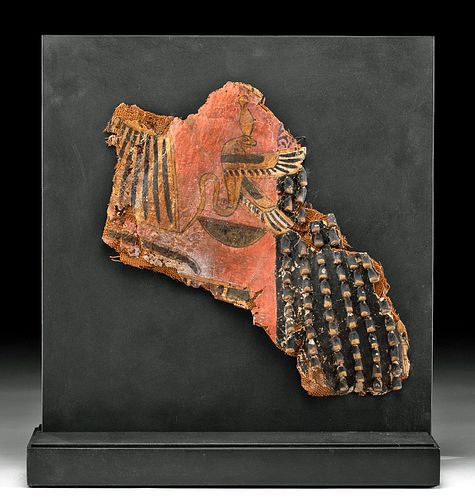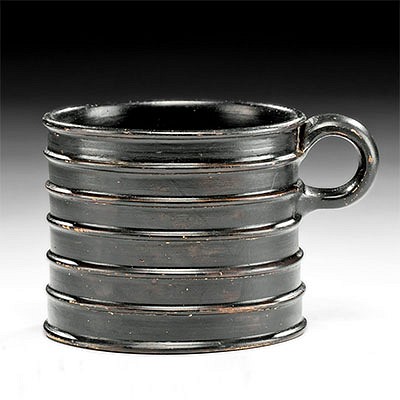Egyptian Cartonnage Fragment - Crowned Uraeus w/ Wings
Lot 11a
About Seller
Artemis Fine Arts
686 S Taylor Ave, Ste 106
Louisville, CO 80027
United States
Selling antiquities, ancient and ethnographic art online since 1993, Artemis Gallery specializes in Classical Antiquities (Egyptian, Greek, Roman, Near Eastern), Asian, Pre-Columbian, African / Tribal / Oceanographic art. Our extensive inventory includes pottery, stone, metal, wood, glass and textil...Read more
Categories
Estimate:
$2,500 - $3,500
Absentee vs Live bid
Two ways to bid:
- Leave a max absentee bid and the platform will bid on your behalf up to your maximum bid during the live auction.
- Bid live during the auction and your bids will be submitted real-time to the auctioneer.
Bid Increments
| Price | Bid Increment |
|---|---|
| $0 | $25 |
| $300 | $50 |
| $1,000 | $100 |
| $2,000 | $250 |
| $5,000 | $500 |
| $10,000 | $1,000 |
| $20,000 | $2,500 |
| $50,000 | $5,000 |
| $100,000 | $10,000 |
| $200,000 | $20,000 |
About Auction
By Artemis Fine Arts
Mar 12, 2020
Set Reminder
2020-03-12 10:00:00
2020-03-12 10:00:00
America/New_York
Bidsquare
Bidsquare : Ancient / Ethnographic Around The World
https://www.bidsquare.com/auctions/artemis-gallery/ancient-ethnographic-around-the-world-4957
Ancient art from Egypt, Greece, Italy and the Near East, as well as Asian, Fossils, Pre-Columbian, Native American, African / Tribal / Oceanic, Spanish Colonial, Russian Icons, Fine art, much more! Artemis Fine Arts info@artemisfinearts.com
Ancient art from Egypt, Greece, Italy and the Near East, as well as Asian, Fossils, Pre-Columbian, Native American, African / Tribal / Oceanic, Spanish Colonial, Russian Icons, Fine art, much more! Artemis Fine Arts info@artemisfinearts.com
- Lot Description
Egypt, Late Dynastic to Ptolemaic period, ca. 664 to 30 BCE. A splendid fragment formed from cartonnage - woven linen covered with gesso and painted - that is a portion of either a royal wig, a funerary wig, or a cartonnage mummy adornment. The right side features dozens of raised conical plugs representing the tips of one's hair. To the left of the hair is a horizontal, bar-shaped ornament adorned with red and blue-green panels encircled with golden yellow pigment, and above is a trapezoidal element with parallel black lines, perhaps representing a gold pectoral collar. The central element is a sinuous uraeus cobra with a petite head topped with the Hedjet crown of Upper Egypt and a pair of outstretched wings. This cobra is likely representative of the snake goddess Wadjet (also Uatchit) or her vulture-form sister Nekhbet who transformed into a snake when displayed with her sister. Size (cartonnage panel): 9.4" W x 9.4" H (23.9 cm x 23.9 cm); (display stand): 12.5" W x 13.4" H (31.8 cm x 34 cm)
While the snake goddess Wadjet (also Uatchit, Buto, Udjo) was most often presented in her serpentine form, her sister Nekhbet (literally "She of Nekheb") was only ever a snake when near Wadjet; otherwise she would assume the form of a vulture. The two snake goddesses are some of the oldest deities in recorded Egyptian mythology, and their inception can be credited to an enormous and exceedingly important geographical feature of ancient Egypt: the Nile River. According to Egyptologist Garry J. Shaw, "For much of Egypt's length, the Nile is a single river, but at the point of modern Cairo and ancient Memphis, it breaks into many channels, forming the great marshland of the Delta; today, there are only two branches, but in ancient times there were five. This great divide between Valley and Delta, created by the Nile, fuelled the Egyptian obsession with dualism; the country could be referred to as 'the Two Lands', each represented by its own crown - the Red Crown for Lower Egypt and the White Crown for Upper Egypt. Furthermore, the goddesses Nekhbet and Wadjet came to represent Upper and Lower Egypt respectively. Nekhbet, meaning 'She of Nekheb' (the site of modern el-Kab), is normally depicted as a vulture and often wears the White Crown, while Wadjet was depicted as a snake wearing the Red Crown." (Shaw, Garry J. "The Egyptian Myths: A Guide to the Ancient Gods and Legends." (Thames & Hudson, London, 2014, p. 134)
Though created with an important purpose in mind, the iconography of this cartonnage fragment is quite curious for two primary reasons. First, the uraeus cobra being shown on the right side of the fragment is typical of Wadjet; however, the white crown of Upper Egypt it dons is typically worn by Nekhbet. Since this cartonnage piece was made during the Late Period, the rules governing funerary imagery were perhaps not as stringent as in previous dynastic periods. With this in mind, it would come as no surprise if the depicted crown was simply an Atef crown - the traditional crown of Osiris, the god of the underworld - viewed from the side so as to not present the ostrich feathers. The second intriguing detail is the orientation of the wings. Traditionally the wings of figures like the goddess Isis or on zoomorphic creatures like the uraeus cobra were outstretched and staggered - with the front wing lowered and the back wing raised regardless of the figure's orientation - as a gesture of protection and spiritual flight into the afterlife. The uraeus cobra shown here, conversely, steadies its wings in the opposite orientation likely due to the relaxed iconographical mandates of later dynastic periods.
Provenance: private New Jersey, USA collection, acquired between 2005 and 2010; ex-private Simonian family collection, Switzerland, formed in the 1970s
All items legal to buy/sell under U.S. Statute covering cultural patrimony Code 2600, CHAPTER 14, and are guaranteed to be as described or your money back.
A Certificate of Authenticity will accompany all winning bids.
We ship worldwide and handle all shipping in-house for your convenience.
#153223This is a fragment of a larger cartonnage item. Repaired from roughly four large pieces, with linen strips on verso for stabilization, and resurfacing with overpainting along obverse. Abrasions and nicks to obverse and peripheries, with light fading and darkening to areas of original pigment, and desiccation to linen verso commensurate with age. Great remains of original pigment throughout, and nice woven linen remains visible on verso.Condition
- Shipping Info
-
All shipping is handled in-house for your convenience. Your invoice from Artemis Gallery will include shipping calculation instructions. If in doubt, please inquire BEFORE bidding for estimated shipping costs for individual items.
-
- Buyer's Premium



 EUR
EUR CAD
CAD AUD
AUD GBP
GBP MXN
MXN HKD
HKD CNY
CNY MYR
MYR SEK
SEK SGD
SGD CHF
CHF THB
THB














